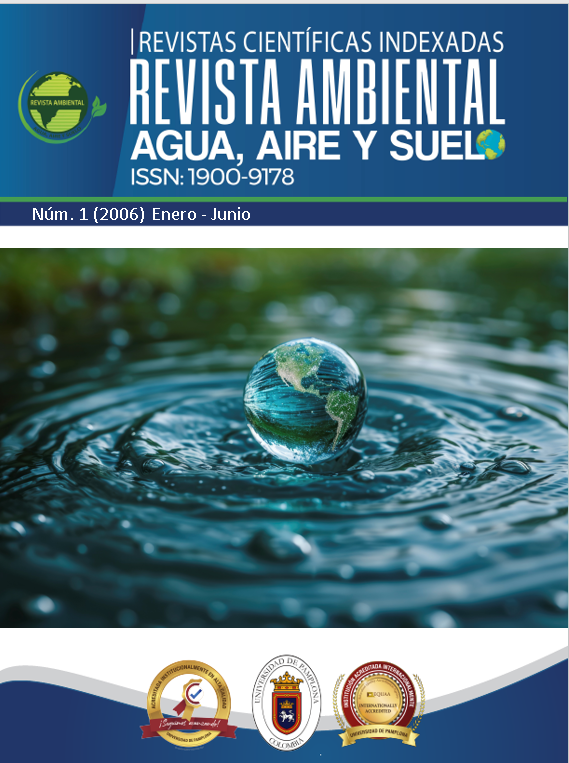Humedar I: an innovative, low-cost alternative for treating wastewater in developing countries
DOI:
https://doi.org/10.24054/aaas.vi1.2053Keywords:
HUMEDAR - I®, macrophytes, biofilms, specific surface area, artificial wetlands, wastewater treatment plant (WWTP), specific surface areaAbstract
A simple and efficient prototype for the treatment of domestic wastewater called HUMEDAR-I® has been designed and researched on a laboratory scale. Several full-scale models have subsequently been built in various communities and human settlements in Colombia. Its configuration involves a parallel-chamber anaerobic piston flow reactor (RACFP), followed by a high-rate constructed wetland.
treatment of domestic wastewater called HUMEDAR - I®, whose configuration involves a parallel-chamber anaerobic reactor with piston flow (RACFP), followed by a high-rate constructed wetland consisting of native macrophytes
and common materials supported on recycled plastic media with a special design of approximately 300 m²/m³ of specific surface area. This scheme has shown advantages over similar processes in terms of cost and achievement of the expected efficiencies for contaminant removal. HUMEDAR - I® does not require routine or continuous maintenance, does not consume electricity, does not require specialized personnel for its operation, and can be used in small towns, agro-industrial and similar industries, camps, neighborhoods, slaughterhouses, and similar facilities that discharge organic loads comparable to those generated in communities of up to 5,000 equivalent inhabitants per unit built. The results obtained from the research carried out confirm that HUMEDAR - I® achieves the required purification of contaminants present in domestic wastewater beyond the levels required by current Colombian regulations (80% organic load). Efficiency values of 92 to 95% have been obtained in the removal of BOD5 and SS, 74 to 79% in nutrients (N and P), and up to four logarithmic orders of magnitude of coliforms in full-scale systems with continuous flow for a total retention time of 18 hours. The effective area used ranges from 0.1 to 0.47 m2/inhabitant equivalent, depending on the population served, which represents a reduction of at least 90% or more compared to the dem
Downloads
References
ARJONA B. Evaluación de un cultivo hidropónico de Penniswetum clandestinum como tratamiento biológico de aguas residuales domesticas. Universidad Nacional de Colombia, Tesis de grado Biología, 1987.
BAENA S. Evaluación del poder depurador de la técnica de película nutriente en la estación de bombeo de aguas residuales El Salitre. Universidad Javeriana, Tesis de grado Biología, 1986.
COLCIENCIAS, Página WEB. Octubre del 2001.
COLLADO L. R. La lenteja de agua como sistema blando de depuración de aguas residuales de bajo coste, en Tecnología del Agua No. 174Cano A. A. marzo de 1998, pg 18-25.
ENVIRONMENTAL PROTECTION AGENCY, EPA. Desing Manual Constructed wetlands and aquatic plant systems for municipal wastewater treatment U.S. 1988
ENVIRONMENTAL PROTECTION AGENCY, EPA. Handbook of constructed wetlands U.S.
ENVIRONMENTAL PROTECTION AGENCY, EPA Subsurface flow constructed wetlands for wastewater treatment: A Technology assessment U.S. 1993.
ESTEVEZ S.F. Diseño y explotación de sistemas de depuración de aguas residuales en pequeños núcleos y comunidades, Asociación nacional de químicos españoles, Agrupación territorial de Castilla la Mancha, Sección técnica de medio ambiente.
GOMEZ RESTREPO, Alvaro Roy. Tesis de grado Ingeniería Ambiental., 2000
GUTIERREZ M. ALVARO M.depuración de aguas residuales domésticas e industriales utilizando especies macrófitas nativas en la granja integral de usme de la uan. UAN. 2004
GRUESO VANEGAS, José Ramón y Lorenza María JARAMILLO GOMEZ, Seguimiento y Evaluación del Prototipo de Planta de Tratamiento de Aguas Residuales Domésticas Fundación Manuel Mejía, Convenio Federación Nacional de Cafeteros-Consejo Británico. Universidad Nacional de Colombia, Sede Manizales, Carrera de Ingeniería Química, Trabajo de Grado.
HARBERL R., PERFLER R., LABER J., COOPER P. Wetland systems for water pollution control., 1996, en Water Science and Technology Vol 35, No 5, 1997.
JHON W ILLW Y & SONS DROSTE, RONALD L. Theory and practice of water and wastewater treatment, , 1997.
KADLEC R.H., BRIX H. Wetland systems for water pollution control 1994, en Water Science and Technology Vol 32, No 3, 1995.
KADLEC R. H, KNIGHT R.L, Treatment Wetlands, CRC Press, 1996.
MARTÍNEZ M, Depuración de aguas con plantas emergentes, en Hojas Divulgadoras, Ministerio de Agricultura, Pesca y Alimentación, 1989.
LARA BORRERO J.A. Depuración de aguas residuales con humedales artificiales. Universidad Politécnica de Cataluña. 1998
METCALF & EDDY. Ingeniería de aguas residuales: Tratamiento, vertido y, 3ª Ed, McGraw- Hill, 1995.
LOPEZ M., P. MOLINA. Ensayos hidropónicos exploratorios para depurar aguas del beneficio del café. Universidad Nacional de Colombia. Tesis de Grado Química, 1998.
REED S.C, CRITES R.W . Natural systems for waste management and treatment, Middlebrooks, E.J, 2ª Ed, McGraw-Hill,1995.
RICHMOND BAVOR H,J.,D. J. ROSER, P. J. FISHER Y J. C., NSW. Smalls, Joint Study on Sewage Treatment Using Shallow Lagoon Aquiatic Plant Systems, Water Research Laboratory Agricultural College, , Australia, 1986
SANABRIA, Otoniel. Proyecto HUMEDAR I. Universidad Nacional de Colombia. 2004
SEOANEZ C. M. Aguas residuales urbanas: Tratamientos naturales de bajo costo y aprovechamiento, Mundi Prensa, 1995.
WATER POLLUTION CONTROL FEDERATION (WEF), ALEXANDRIA. Natural Systems for Wastewater Treatment, Manual Of Practice Reed, S. C., FD-16, VA,1990.
Downloads
Published
Issue
Section
License
Copyright (c) 2022 REVISTA AMBIENTAL AGUA, AIRE Y SUELO

This work is licensed under a Creative Commons Attribution-NonCommercial 4.0 International License.










